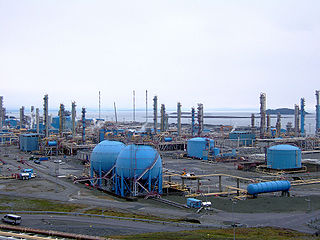Related Research Articles

Ekofisk is an oil field in block 2/4 of the Norwegian sector of the North Sea about 320 km (200 mi) southwest of Stavanger. Discovered in 1969 by Phillips Petroleum Company, it remains one of the most important oil fields in the North Sea. This was the first discovery of oil after the drilling of over 200 exploration wells in the North Sea "triggered" by the Groningen gas field discovery. In 1971, Phillips started producing directly to tankers from four subsea wells. Oil production is planned to continue until at least 2050.

The Statfjord oil field is a large oil and gas field covering 580 km2 along the U.K.-Norwegian boundary of the North Sea at a water depth of 145 m, discovered in 1974 by Mobil and since 1987 operated by Equinor.

Snorre is an oil and gas field in the Tampen area in the southern part of the Norwegian Sea. The sea depth in the area is 300 to 350 metres. Snorre has been operational since August 1992. It was the first field developed by Saga Petroleum.

The Langeled pipeline is an underwater gas pipeline transporting Norwegian natural gas to the United Kingdom. Before the completion of the Nord Stream 1 pipeline, it was the longest subsea pipeline in the world.
Gassco is a Norwegian state owned company that operates 7,800 kilometres (4,800 mi) of natural gas pipes transporting annually of 100 billion cubic meter (bcm) of natural gas from the Norwegian continental shelf to Continental Europe and Great Britain.
Vesterled is a natural gas pipeline system, which runs from the Heimdal field in the North Sea to St Fergus Gas Plant near Peterhead in Scotland. The name Vesterled is the term used by the Vikings for their westward voyages, i.e. vesterled = "the way westward".
The Franpipe is a 840 kilometres (520 mi) long natural gas pipeline from the Draupner E riser in the North Sea to the receiving terminal at Port Ouest in Dunkirk, France. The gas transported to France originates mainly from Sleipner East and Troll Vest gas fields. The pipeline was officially inaugurated on 9 October 1998.
The Zeepipe is a natural gas transportation system to transport North Sea natural gas to the receiving terminal at Zeebrugge in Belgium.
Europipe I is a 670-kilometre-long (420 mi) natural gas pipeline from the North Sea to Continental Europe.

Europipe II is a natural gas pipeline from the Kårstø processing plant north of Stavanger to a receiving terminal at Dornum in Germany. It came on stream on 1 October 1999.
Norpipe is a subsea oil and natural gas pipelines system in the North Sea. It supplies oil from the Norwegian Ekofisk and associated fields in the North Sea to the United Kingdom and natural gas to Germany.

Kollsnes is a natural gas processing plant operated by Equinor on the southern part of the island of Oøy in Øygarden Municipality in Vestland county, Norway. It processes the natural gas from the Troll, Kvitebjørn, and Visund gas fields. Kollsnes has a capacity of 143,000,000 cubic metres (3.8×1010 US gal) of natural gas per day.

Kårstø is an industrial facility located near the village of Susort, along the Boknafjorden, in the municipality of Tysvær in Rogaland county, Norway. The site features a number of natural gas processing plants that refine natural gas and condensate from the fields in the northern parts of the North Sea, including the Åsgard, Mikkel, and Sleipner gas fields. The Kårstø processing complex is Europe's biggest export port for natural gas liquids (NGL) and the third largest in the world. The industrial site is also the location for the now-closed Kårstø Power Station.
Skanled was a planned natural gas offshore pipeline connecting Norway to Sweden and Denmark.
NorSea Com-1, now called Tampnet, is a submarine telecommunications cable system in the North Sea linking the UK and Norway, and connecting five off-shore platforms.
Gassled is a partnership to own the offshore natural gas transportation infrastructure at the Norwegian continental shelf. Its pipelines are operated by Gassco.
Oseberg Transport System (OTS) is a pipeline system in western Norway. It is 115 km (71 mi) long and runs from Oseberg, Veslefrikk, Brage, Frøy and Lille-Frigg to Sture terminal, located 65 kilometres (40 mi) north of Bergen, Norway on Alvøy island. The operation of the pipeline was commenced in 1988. Total investment in the pipeline construction was about 9.8 billion NOK.
The Draupner platform is a gas platform for the extraction of natural gas in the North Sea consisting of the Draupner S and E riser platforms. It is located in the Norwegian North Sea block 16/11 160 km (99 mi) offshore from Norway. The complex consists of seven risers and two riser platforms standing in 70 m (230 ft) water depth and linked by a bridge. Draupner E is the first major oil platform using jacket-type construction supported on a bucket foundation and suction anchors. The complex is owned by Gassled and operated by Gassco. The technical service provider is Equinor.
Heimdal is an offshore natural gas field in the North Sea located 212 kilometres (132 mi) northwest of Stavanger, Norway. Heimdal serves as a connection hub for processing and distribution of natural gas from satellite fields.
Haltenpipe is a gas transport system which consists of a 250 kilometres (160 mi) long pipeline from the Heidrun field to Tjeldbergodden. It started operation in December 1996, and is operated by Gassco. Transport capacity is 2.2. billion cubic metres per year.
References
- 1 2 "Statpipe Gas Celebrates 20 Years in Operation". Statoil . Rigzone. 17 October 2005. Retrieved 15 November 2009.
- ↑ "GasLed leads way". Upstream Online . 20 December 2002. Retrieved 15 November 2009.
- 1 2 Oilfield Publications Limited (1985). The North Sea Platform Guide. Ledbury UK: Oilfield Publications Limited. pp. 636–40.
- ↑ "Pipe peace in Norway". Upstream Online . 3 May 2002. Retrieved 15 November 2009.